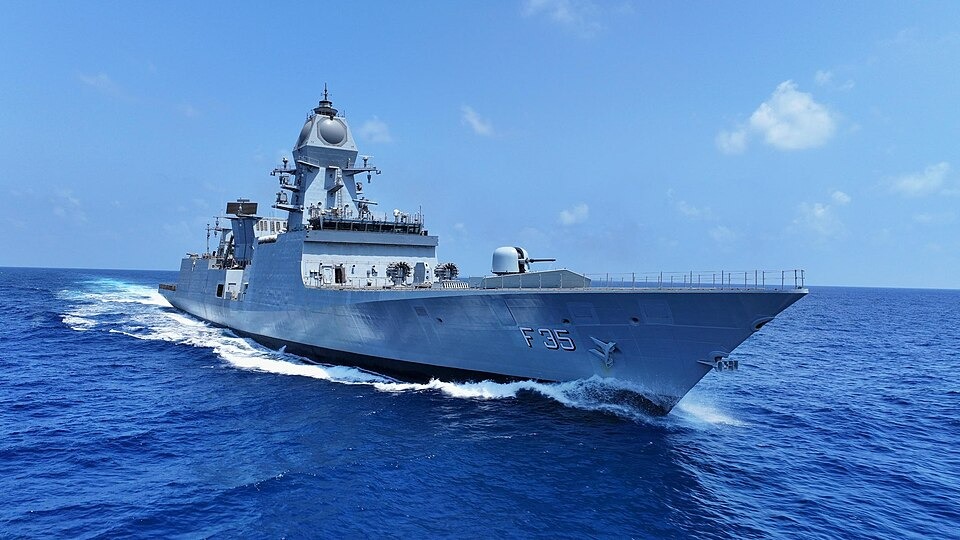India’s naval strength received a significant boost today with the formal commissioning of two next-generation stealth frigates, INS Udaygiri and INS Himgiri, at a grand ceremony attended by senior naval officials, defence leaders, and government dignitaries. The induction of these state-of-the-art warships not only strengthens the Indian Navy’s combat readiness but also marks another milestone in India’s ambitious journey of building an indigenous and self-reliant defence ecosystem under the Atmanirbhar Bharat initiative.
The two stealth frigates, both built under the Project 17A programme, represent cutting-edge technology, advanced weapon systems, and enhanced stealth capabilities, making them formidable assets for safeguarding India’s vast maritime interests across the Indo-Pacific region.
A Milestone in India’s Naval Modernisation
A blue-water navy that can operate in far-off waters to safeguard national interests is crucial, according to India’s maritime doctrine. The commissioning of INS Udaygiri and INS Himgiri aligns with this doctrine, giving the Navy greater operational flexibility, surveillance power, and combat capability.
Both frigates belong to the Project 17A class, a series of seven advanced frigates being constructed indigenously at Mazagon Dock Shipbuilders Limited (MDL), Mumbai and Garden Reach Shipbuilders and Engineers (GRSE), Kolkata. The ships are the successors of the successful Shivalik-class frigates (Project 17) and come with superior stealth features, automation, and survivability measures.
With these additions, India continues to reduce its reliance on foreign-made warships and accelerates its Make in India defence manufacturing push.
The Significance of Project 17A
Project 17A is a crucial part of the Navy’s modernisation roadmap. The project aims to build seven advanced stealth frigates, of which INS Udaygiri and INS Himgiri are the most recent additions.
Key highlights of Project 17A warships include:
Stealth Features: Radar cross-section reduction through specially designed hull and superstructure shapes.
Multi-mission capability: Ability to conduct simultaneous anti-air, anti-surface, and anti-submarine combat missions.
Automation: Advanced control systems for weapons and sensors, reducing crew workload.
Indigenous Content: Nearly 75% of the equipment and systems onboard are sourced from Indian companies.
Network-Centric Warfare: Equipped to operate seamlessly with India’s naval, air, and land forces.
The commissioning of these ships represents India’s growing shipbuilding capability and its vision of becoming a net security provider in the Indian Ocean Region (IOR).
INS Udaygiri: A Modern Guardian of the Seas
INS Udaygiri is the third ship of the Project 17A class built at MDL, Mumbai. The ship, which is named after the Andhra Pradesh Udaygiri Hills, is a representation of fortitude, tenacity, and resiliency.
Key features of INS Udaygiri include:
Displacement: Over 6,600 tonnes
Speed: Capable of exceeding 28 knots
Weapons: featuring torpedo launchers, Barak-8 surface-to-air missiles, and BrahMos supersonic cruise missiles.
Sensors: State-of-the-art radar and sonar systems for air and submarine detection
Helicopter Operations: Can embark advanced multi-role helicopters like MH-60R or HAL Dhruv for extended surveillance and anti-submarine roles
INS Udaygiri is designed for long-endurance missions, allowing the Navy to deploy her for operations across the Indian Ocean and beyond, extending into the wider Indo-Pacific theatre.
INS Himgiri: A Stealth Sentinel
The second ship of the Project 17A class, INS Himgiri, was constructed at GRSE in Kolkata. Named after the majestic Himalayan peak Himgiri, the ship embodies strength and unwavering defence.
Highlights of INS Himgiri include:
Stealth Technology: Special hull design and coatings reduce radar signature.
Armament: BrahMos missiles, anti-submarine torpedoes, advanced gunnery systems, and vertical launch missile systems.
Electronic Warfare Suite: Capable of detecting, tracking, and neutralising multiple threats simultaneously.
Crew Comfort: Modern living spaces and automation reduce crew fatigue during prolonged missions.
Role: Designed for multi-dimensional combat, maritime patrol, and fleet support operations.
The Navy’s anti-air and anti-submarine capabilities are greatly enhanced by INS Himgiri, which makes it an invaluable tool for defending sea lines of communication (SLOCs) in the Indian Ocean Region.
Boost to Maritime Security
The commissioning of INS Udaygiri and INS Himgiri comes at a time when maritime security has become central to global geopolitics. The Indo-Pacific is witnessing increased strategic competition, piracy threats, and disputes over freedom of navigation. For India, with its 7,500-km-long coastline and critical shipping routes, securing maritime interests is a top priority.
The new stealth frigates will:
- To combat the increasing submarine presence in the Indian Ocean, anti-submarine warfare (ASW) capabilities should be strengthened.
- Enhance air defence coverage for fleet and coastal security.
- Provide surface strike capabilities using BrahMos missiles, offering precision strike power.
- Support humanitarian assistance and disaster relief (HADR) missions.
- Boost India’s participation in joint naval exercises with partner nations like the U.S., Japan, Australia, and France.
Strategic Importance
India’s naval expansion through ships like Udaygiri and Himgiri is not just about defence preparedness but also about strategic signaling. The Indian Ocean Region is a critical artery for global trade, with over 60% of world oil shipments and 90% of global trade by volume passing through it.
The new frigates:
- Reinforce India’s role as a regional security provider.
- Strengthen deterrence against potential adversaries in the region.
- Increase India’s ability to project power beyond its immediate neighborhood.
- Work with friendly fleets to support freedom of navigation operations (FONOPS).
Indigenous Defence Ecosystem
One of INS Udaygiri and INS Himgiri’s most notable achievements is the high degree of indigenization they have achieved. Nearly three-fourths of the equipment onboard has been sourced from Indian defence firms, including both state-owned enterprises and private companies.
Contributors include:
- BrahMos Aerospace: Missile systems
- Bharat Electronics Limited (BEL): Radar and electronic warfare systems
- Garden Reach Shipbuilders & Engineers (GRSE): Shipbuilding expertise
- Mazagon Dock Shipbuilders Limited (MDL): Hull construction and integration
- Private Sector Firms: Pumps, motors, and auxiliary systems
This not only strengthens India’s defence industrial base but also generates jobs, technology transfer, and long-term capability in shipbuilding.
Voices from the Ceremony
During the commissioning, senior leaders highlighted the strategic importance of the event.
- Defense Minister Remarks: He underlined that the launch of Udaygiri and Himgiri underscores India’s technological maturity and the Atmanirbhar Bharat objective.
- Navy Chief’s Statement: The Chief of Naval Staff described the frigates as “force multipliers” that will operate as key assets in the Navy’s frontline fleet.
- Shipyard Leaders’ Perspective: Both MDL and GRSE reaffirmed their commitment to delivering world-class warships to strengthen India’s maritime security.
India’s Naval Future
The commissioning of INS Udaygiri and INS Himgiri is part of a larger naval modernization program. India is already engaged in the following projects:
- Project 15B Destroyers (Visakhapatnam class)
- Scorpène-class submarines (Kalvari class)
- Indigenous Aircraft Carrier INS Vikrant
- Next-Gen Destroyer and Submarine projects
By the end of this decade, the Indian Navy aims to operate a 175-ship fleet, including aircraft carriers, nuclear submarines, and advanced frigates.
Global Partnerships
The commissioning also enhances India’s ability to operate jointly with global navies. Exercises like Malabar (with US, Japan, Australia), Varuna (with France), and Indo-Pacific maritime patrols will see Udaygiri and Himgiri participating in high-seas drills, strengthening interoperability and deterrence.
India’s growing naval power also reassures smaller Indian Ocean nations who depend on India for maritime security cooperation, disaster relief, and capacity-building support.
For India’s naval community and defense industry, the induction of INS Udaygiri and INS Himgiri into the Indian Navy is a momentous occasion.
As next-generation stealth frigates, they represent the perfect blend of indigenous design, advanced weaponry, and futuristic technology.
Their commissioning not only strengthens India’s maritime defence posture but also sends a powerful message of India’s determination to safeguard its seas, protect its trade routes, and contribute to global maritime security.
As the tricolour fluttered proudly on their decks today, INS Udaygiri and INS Himgiri set sail as symbols of a self-reliant, confident, and strong India ready to secure the oceans of tomorrow.
Related News: Read More




Pingback: Eco-Friendly Transport: PM Modi Unveils Green mobility..